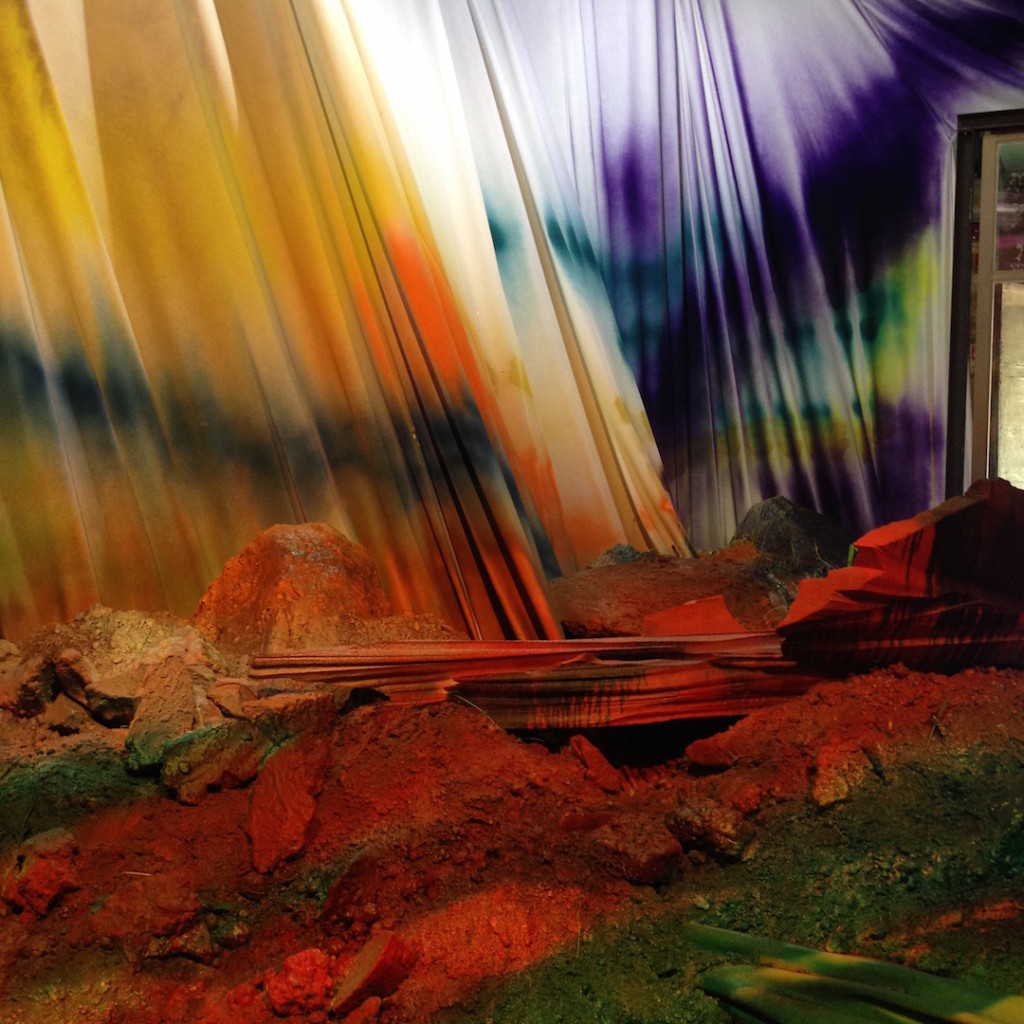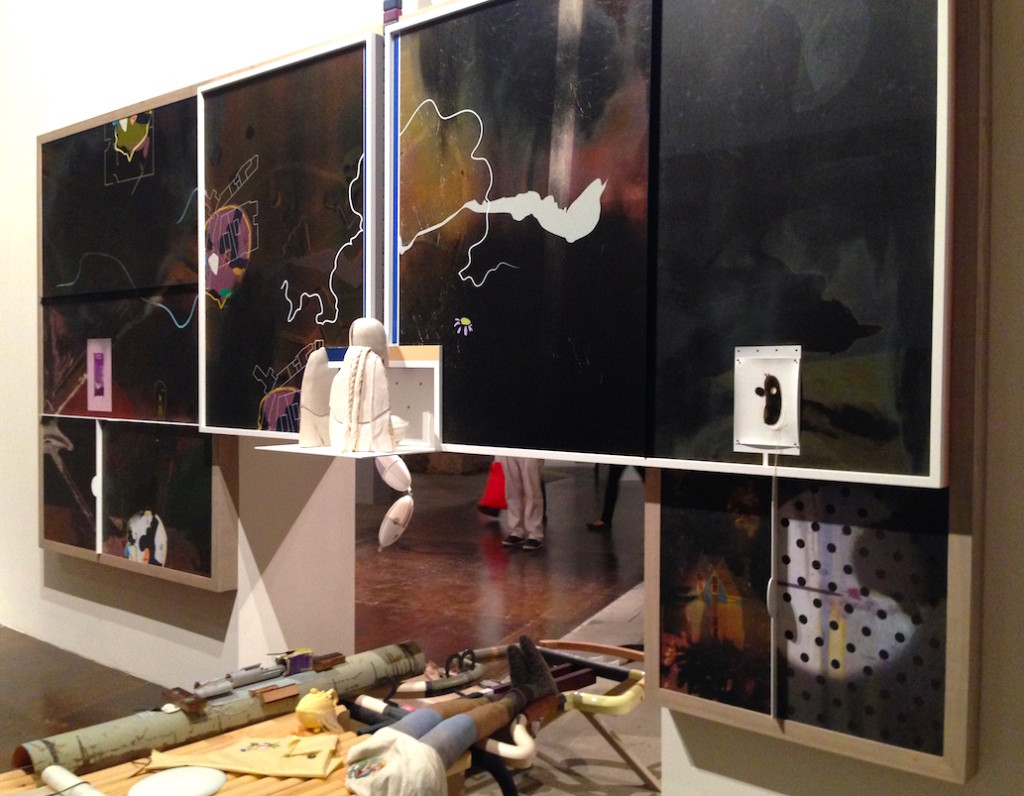The Biennale di Venezia is a large, or rather enormous, exhibition. Bringing together globally selected artists who at times rather than communicate to a contemporary moment, speak of the past. As mentioned above, an early critical observations is that much of pairings do not do each other justice or in many cases isn’t the best representation of from a particular artists oeuvre. A perfect example of this was a series of building models by Isa Genzken of unrealized architectural projects awkwardly paired with the small, black and white photographs of Depression-era photographer Walker Evans installed in the Central Pavilion of the Giardini. Spatially the coupling makes sense in the simplest terms −photographs on the wall, sculptures filling the floor space− however the poetics are more interesting than the realization where the dialogue falls flat. Another artist (and sometimes top-pick) whose work has also been strong in the recent past but fails here is Walead Beshty whose contribution to the Central Pavilion is a series of sculptures made of various objects, ceramic and appearing to be painted with drippy black paint with red accents. They are −for those who follow my writing know this is a word I rarely use− terrible. A political meaning may/does rest below the surface but even still, the aesthetic language is not engaging enough for one to investigate further. Appealing from a distance, up close these sculptures, in at least two locations in the Central Pavilion, look as if they could have been made by an engine mechanic with excess car paint and a collection of discarded materials ranging from children’s toys to tires. Also nearby are a series of objects by Jeremy Deller that have a stronger aesthetic appeal than the aforementioned, but could have been taken further, also the addition of an audio component would have been more interesting.

Hans Haacke, World Poll, 2015, as part of the 56th Biennale di Venezia, All The World’s Future, Photograph by Katy Hamer, 2015
It could easily be argued that the inauguration of the Biennale is not the best time to look at art. As soon as the metaphoric ribbon is cut, artwork must sing and sing quickly. Video lasting over twenty minutes becomes too long, performance needs to be loud enough to be heard or soft enough for those present to want to lean in. Such was the case with Allora & Calzadilla,
In the Midst of Things (2015), in which a choral group will perform an arrangement of Joseph Haydn’s oratorio
The Creation at the Arsenale. A live audio performance featuring professional opera singers, their octave tonalities echoed through the first few galleries attracting those nearby. A vocal and gestural dialogue between three men and three women, who move forward and return backwards as does their conversation. Their bodies moving in between hanging two-dimensional artworks, activated the space: blood cells flowing through veins. Other artists who sparkled at the Arsenale included
Mika Rottenberg,
Adrian Piper winner of the Golden Lion for best artist (showing a participatory a piece that
I wrote about for Flash Art and had been on view at Elizabeth Dee Gallery in NY),
Tania Bruguera, Fabio Mauri and Oscar Murillo. While at the Central Pavilion of the Giardini stand-outs included Rosa Barba,
Hans Haacke who contributes an on-going iPad activated questionnaire, and
Fabio Mauri who has been included in multiple venues. Mauri, who died in 2009 has a strong presence in
All The Worlds Futures, having the first room as one enters the Central Pavilion, along with works at the Arsenale his estate is now represented by Hauser & Wirth. His is really about mortality, as is much of the successful work included in the Enwezor show, whereas things end rather than begin. It is either a dark projection or a dark reflection, the antithesis of the rose-colored lens. Here we are shown works that are evident in a political exposé from the past that for the most part still make sense today, in fact looking at the work it would be quite easy to assume it was made by a much younger artist. The surprising element of the exhibition is that some work would probably sore in another circumstance (more space, less noise) and is diminished here, lost in its own residual compositional sentimentality. Such is the case with an installation by
Thomas Hirschhorn (
Roof Off, 2015) that is over-installed, visually too big for the location, a back room of the Central Pavilion. Hirschhorn, known for spatial fullness in his installations is swallowed by the space and seems oddly placed. The work of
Hans Haake, specifically
World Poll, 2015, a few rooms over has a larger visual scope, minimally installed and yet growing as it is participated in as graphs/answers are being printed on A4 paper and lining the wall. Performances will occur throughout the Biennale in a temporary theater, called The Arena, built-in a room that for Robert Storr’s biennale held paintings by Sigmar Polke. On the day of my visit I found a particular musical performance distracting from nearby paintings, Isaac Julian’s performance of
Das Kapital has received mixed reviews. There is something about a visceral performance that enters and leaves a venue having a particular fluidity versus, (distinctly in a large, curated exhibition) something occurring in a theater which feels static or obligatory, requesting a different level of time. As with the ongoing Allora & Calzadilla performance, the strength lies in the happening, the moment that enters into our particular sphere whether invited or not. In 2013, curator Massimiliano Gioni included Tino Seghal in the Central Pavilion with a work so subtle it wasn’t always obviously recognized as performance. Also the Encyclopedic Palace (2013) the
S.S. Hangover (2013) by Ragnar Kjartansson −still one of my favorite works of all time− was afloat in the Arsenale, accompanied by instrumentalists, revealed itself upon approach by melodic audio, while also being spatially and optically captivating. There is often magic in subtlety which is something the presence of a theater within an art venue (in this context) doesn’t lend itself to.
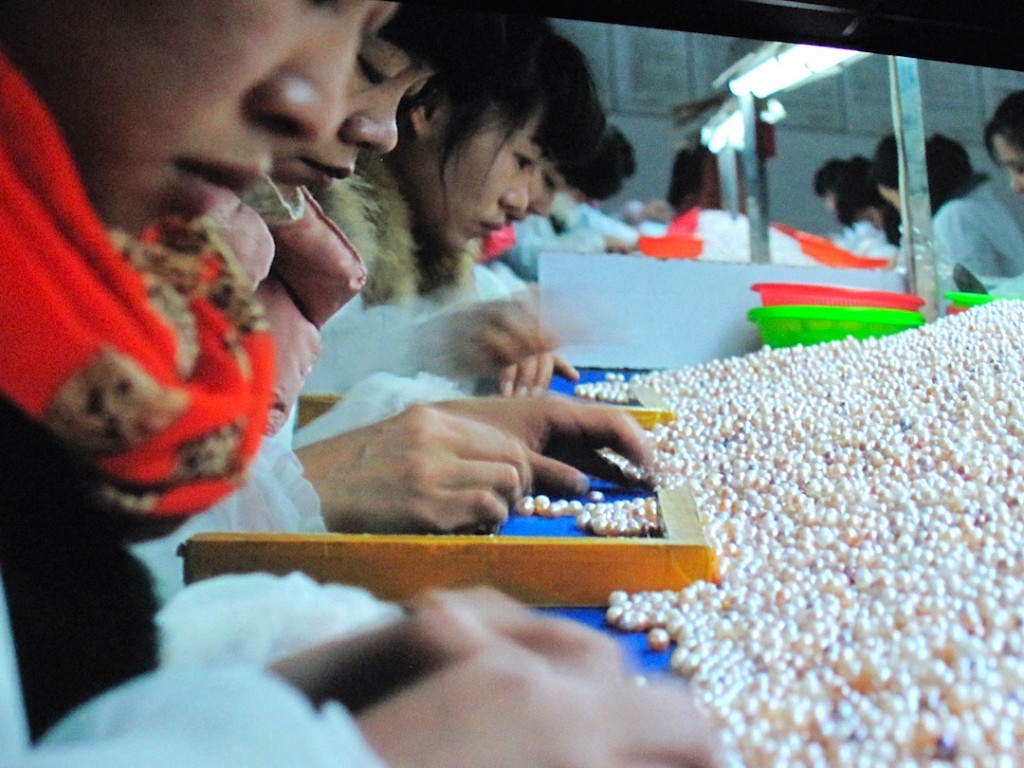
Mika Rottenberg, Still from her film at the Arsenale “NoNoseKnows” (2015), part of the 56th Biennale di Venezia All The World’s Futures, Photograph by Katy Hamer, 2015
Under the umbrella of
All The World’s Futures, the individual country-specific pavilions in the Giardini and various locations throughout the city, were not curated by Okwui Enwezor. Here curators hired by or selected by respective countries, offer individualized perspectives with art that may or may not be specific to the represented nationality. In some cases these micro group shows, part of the larger exhibition but also unique in mood and effect, can feel completely unto their own. Where this group dynamic has worked best in particular can be found in the pavilions of Belgium, Holland, and Spain. Located within the confines of the, Giardini, each present group shows that include artists such as
Adam Pendleton (American showing with Belgium) and Elisabetta Benassi (Italian showing with Holland), and
Pepo Salazar and Salvador Dalì respectively representing Spain, along with a few others. Rather than have drawings or paintings by Dalì, the curator of the Spanish Pavilion chose to show interviews and some of his experimental films, hung on bright pink walls and comfortable surface to sit on. In one of the interviews with
Merv Griffin in 1965 originally shown on American television, Dalì states, “Time is the same as Coeur du Berry cheese, it melts and is elastic.” So true. At the Dutch pavilion, Elisabetta Benassi made an installation (
M’FUMU, 2015) of porcelain dinosaur bones that form a throne. For the duration of the exhibition on the throne sits a man who reads King Leopold’s Soliloquy by Mark Twain which is alternated between English and Italian. The piece is one if the strongest in the Biennale, merging performative interaction with language and sculpture. There is something quite contemporary about the Twain text and a first person narrative makes it feel quite direct and even personal. The reader engages visitors looking and speaking in their general direction, to them even.
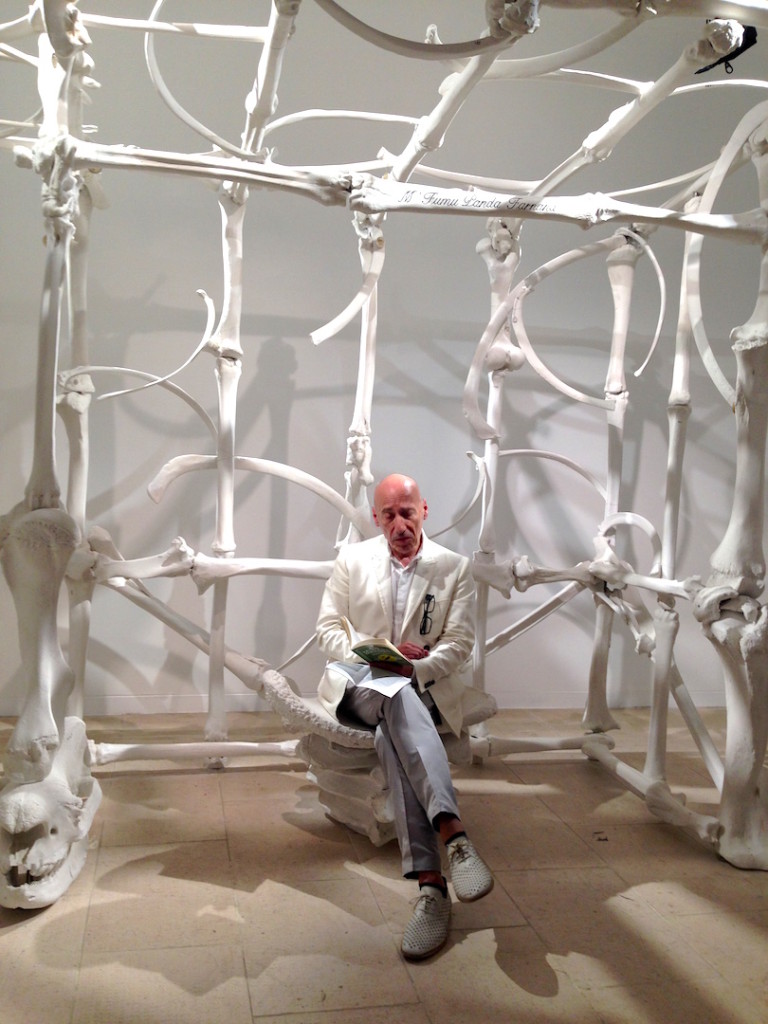
Elisabetta Benassi, M’FUMU, 2015, Site-specific installation and performance as part of All The World’s Futures, Biennale di Venezia, Photograph by Katy Hamer, 2015
Another artist that spawned conversation, including the introductory quote in this article, is
Heimo Zobernig at the Austrian Pavilion. Initially perceived as ’empty’ and conceptually the opposite than the many multi-artist pavilions, this work is so subtle it could be missed. Zobernig raised the floor to be the same level as the entrance and dropped the ceiling, by way of a barely discernable ‘block’ that seems to be floating above. The materials are painted a matte black and only if the visitor was familiar with the original layout of the building, could these changes be perceived. Located nearby was the Romanian Pavilion showing Pace Gallery represented artist,
Adrian Ghenie, with a series of oil paintings titled “Darwin’s Room”. Aesthetically poles apart from Zobernig’s work -simultaneously providing the viewer with a task and space for introspection- Ghenie’s paintings are skillfully made and hanging on the wall, ready for consumption.
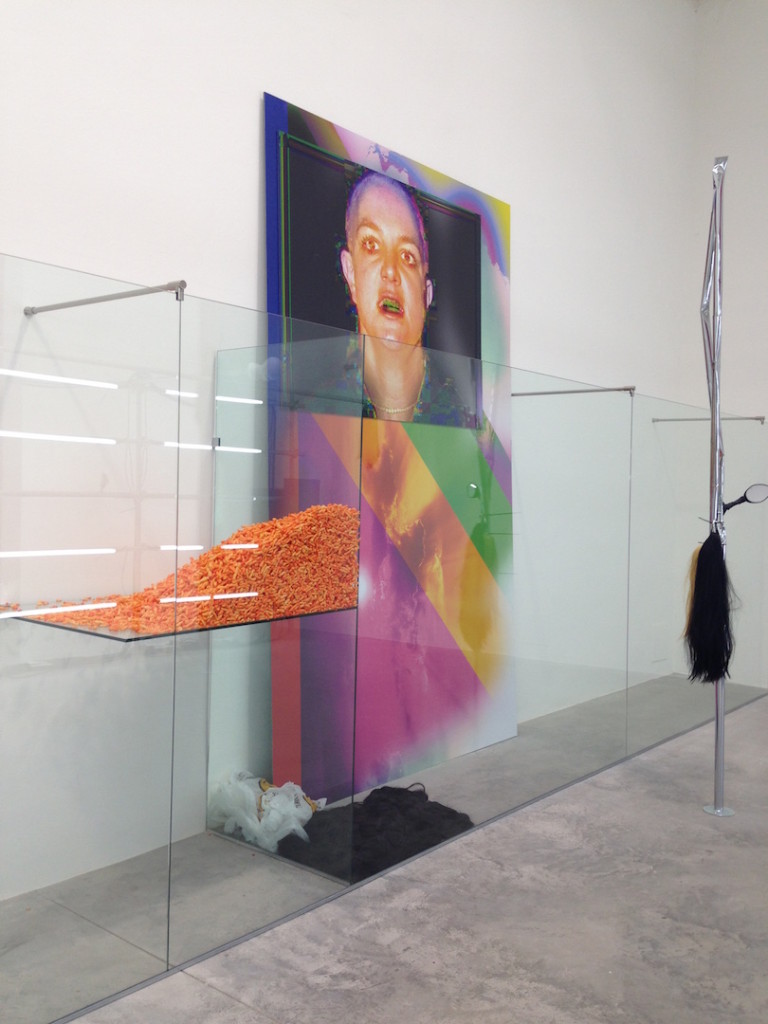
Pepo Salazar, 1. What rests from a total (The metal party Venice version) 2. The very elements of the right succession (high performance alliance), Work it out, Work it out. Keep in moving higher, Keep it building higher, 2015, As part of the 56th Biennale di Venezia, Spanish Pavilion, All The World’s Futures, Photograph by Katy Hamer, 2015
When it comes to the pavilions of the Giardini, a solo exhibition, with one unique artist seems to work best,. This was true two years ago in the German Pavilion with a mammoth installation by the late
Christoph Schlingensief, and year nothing comes close to being that epic. One of the most positive evolutions for 2015 is the inclusion of more women artists than previously presented. This is celebratory, a ploughing of the playing field, if not equalizing. American artist
Camille Norment who is based in Oslo and represents the Scandinavian Pavilion, made a dynamic, uncanny installation, expanding upon the concept of silence with sound. Norment, a officianado with the glass harmonica has made an audio sculpture using voice as well as instruments to envelope the architectural interior. The sounds are projected out through larger-than-life microphones (actually speakers) extending from the ceiling, nearly offering the viewer the opportunity to respond to the eerie, anti-narrative soundtrack. During a panel discussion, the artist stated, “Excitation-to be shaken up/stirred, joyous, ecstasy, or traumatic. The sound of excitation/a body itself the Nordic Pavilion, suspended in the moment of being shaken (hence the sculptural intervention of the space) architectonically formal but moral and political implications.” All of the windows of the pavilion have been recreated, mirroring the originals and lie displaced, twisted and broken, as if a tornado hit the building before installation. Then adding, “the windows that are like membrane connecting inside from outside. Microscopic exploration of vibration and movement.” The work is physically inclusive with invisibility and alarming as it is in part based on the artists’ own experience in her studio when windows shattered after the bombings in Oslo in 2011. While open for interpretation and personal reflection, many noted during the preview that it functions as a place to find solace amongst chaos.
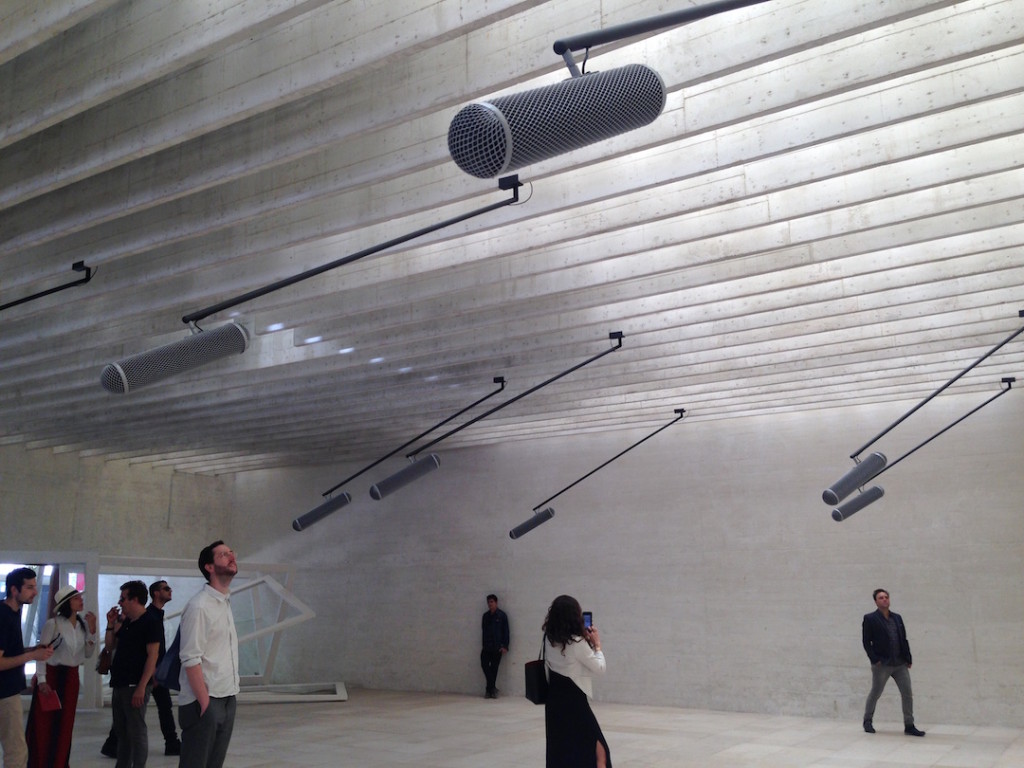
Camille Norment at the Nordic Pavilion, as part of the 56th Biennale di Venezia All The World’s Futures, Photograph by Katy Hamer, 2015
Similar to how Norment uses the structure of sound in an otherwise empty space,
Pamela Rosenkrantz has made the entire interior of the Swiss Pavilion into a pink lake. The color is fleshy and awkward as it is pretty. On her installation,
Our Product, 2015, Rosenkrantz states, “[It is a] summation of european skin tone. Neuroscience is just a concept and constantly changes. Skin is something I like to take and contradict thoughts with.”
One of the most positive evolutions for 2015 is the inclusion -of what feels like- many more women artists. This is celebratory, a ploughing of the playing field, if not equalizing. Beyond Pamela Rosenkranz and Camille Norment whose installations proved some of the strongest, Joan Jonas held down the American Pavilion, following in the footsteps −with residuary dust still on the floor− of Sarah Sze (2013), Jonas has made a work (They Come To Us Without A Word, 2015) that flows from room to room, much like the thematic water that is referenced. The piece, is one of the most direct in its analysis and representation of corporeality. A series of narrated videos, drawings and sculptures weave an intricate phantasmagoric tale combining past and present, life and afterlife, proposals of being. The work is what feels like figurations of truth. At times using Murano glass including the viewer via reflection, family and folklore that seems to follow a personal history. Words about home, traveling in the dark, kerosene lamps, fantasy versus reality, merge in story telling and children in motion on the screens. In excerpt:
A light used to follow him
They were going home and a light approached them. She couldn’t see it. He put his hand on his face and the light shone through her fingers…..he’s still living but he got rid of that light years ago. It quit bothering him…
In a conversation with Norment, Rosenkranz and Joan Jonas organized by the
Office of Contemporary Art Norway (OCA), and moderated by Tim Marlow Direct of Exhibitions at the Royal Academy of Arts, London, Jonas stated, “The American Pavilion is a Jeffersonian building and became a house, a domestic space. [I am interested in] the figure in space, my body and other bodies. The fragility of nature is channeled or filtered through children and out of body experience. I referenced John Berger’s ‘How We Look At Animals’ to address creatures and how will remember them, along with a sadness that is addressed via [visual] poeticism versus world events or happenings.” Then adding “The process of demystifying [art] is making something more real.” In the work, bees, fish and wind all become elements as important as a brush stroke composing a painting.
A journey always leads to something, whether sought after, planned, or not.
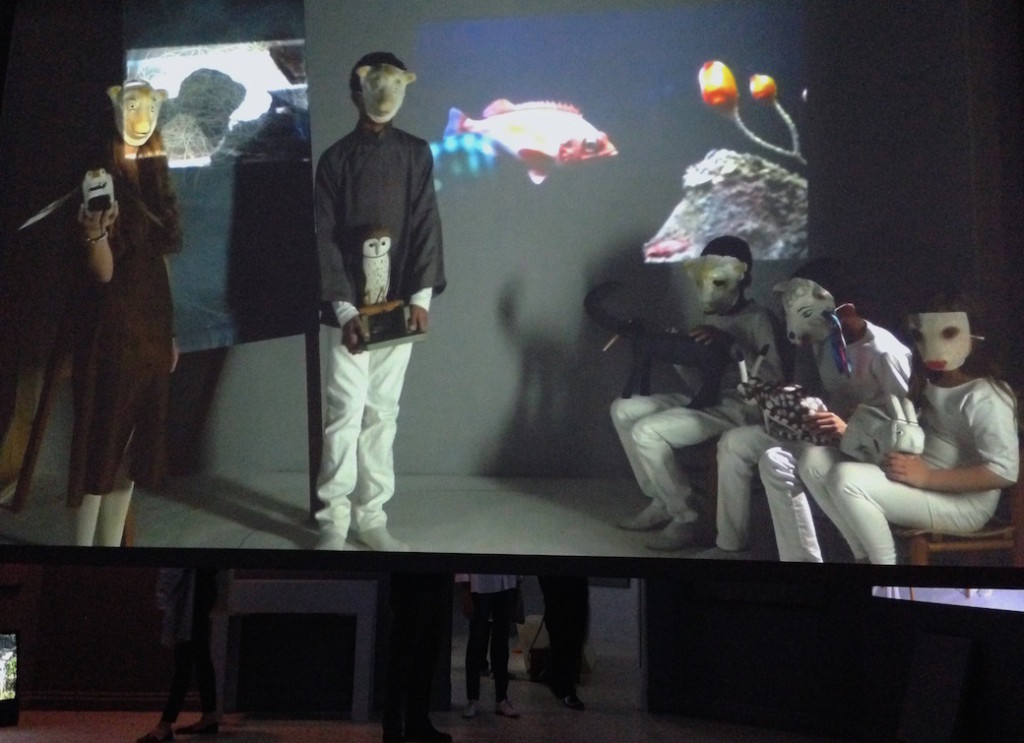
Joan Jonas, The Come To Us Without A Word, (Detail) Film and sculptural installation, As part of the 56th Biennale di Veneiza All The World’s Futures, Photograph by Katy Hamer, 2015
Backpedaling to the Arsenale and “All The World’s Futures” while on the topic of female artists, one of the most physically and politically engaged pieces is by Cuban artist (currently unable to venture to Venice as she is dealing with political issues in Havana around
a public artwork) Tania Bruguera. The untitled work (Sin titolo, Havana 2000) is installed in a small-ish gallery off the main drag of the Arsenale and therefore easy to overlook. During the days of the preview, a short line extended from the dark, cool doorway enticing those nearby to inquire about the interior content. What could be described as a crunching or crashing sound was audibly present and at first thought to be water, waves lapping an artificial shore. Instead, pebbles, deep enough to sink into, filled the expanse of the floor and a small 13 inch tv hung towards the back wall, ceiling. As one’s eyes adjusted to the darkness, it was evident that several unclothed men were in the room, alternating between standing erect and rubbing down their bodies in a gesture of ridding the body of bugs or washing oneself. This silent movement, combined with the crunching of stones under the weight of visitors, makes this work my personal favorite of the Arsenale. Being performed for the second time ever but the first in Venice, the work combined with the knowledge of the political strife the artist has experienced, is a quiet call for action, a tear, and a reminder of the universal importance of freedom of expression and the fact that silence can be interrupted by the presence of even one body.
While parts of the 56th Biennale di Venezia were disappointing, many artworks do stand out. If one is able to see beyond the chaos and have patience, there are works that can be carried, if not literally but metaphorically and will hopefully survive through the next iteration. ~KDH

Helen Sear, “…the rest is smoke ” 2015, Wales in Venice, 56th Biennale di Venezia, Photograph by Katy Hamer, 2015
*Note that without even having touched upon the numerous external pavilions, one of the best and worth the trip to find in the small side streets near the Palazzo Grassi, is the Cyprus Pavilion. Showing the work of Christodoulos Panayiotou and curated by Omar Kholeif, the exhibition titled Two Days After Forever, is an amalgamation of physical and political references from Greece, Cyprus and even Venetian culture. The artist has made subtle interventions that bring together original (transported) materials, such as shredded money and ancient tiles, along with shoes that he had made in Italy using counterfeit handbags sold on the streets of Venice. Bringing together histories, along with contemporary action, Panayiotou makes on of the boldest, even if understated, utterances within the entire biennale. Another external pavilion worth hunting for in the Castello neighborhood is presented by the Arts Council of Wales. A particular favorite, “…the rest is smoke” a mixed media installation by artist Helen Sear, presents a dizzying video along with several photographs and a site-specific installation inspired by the symbolic myth and martyrdom of Saint Sebastian.
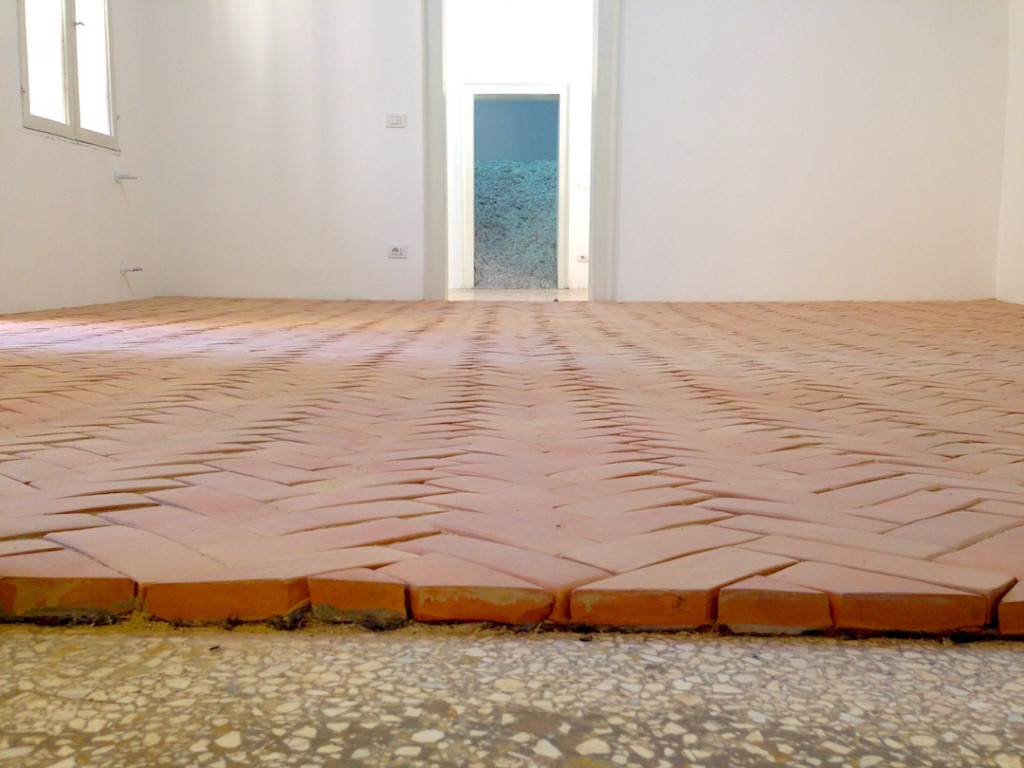
Christodoulos Panayiotou, Cyprus Pavilion, Installation view located by Palazzo Grassi, Part of the 56th Biennale di Venezia, Photograph by Katy Hamer, 2015
-

-
Thomas Hirschhorn installation detail, (Too big and cramped to get full view), as part of the 56th Biennale di Venezia, All The World’s Future, Photograph by Katy Hamer, 2015
-
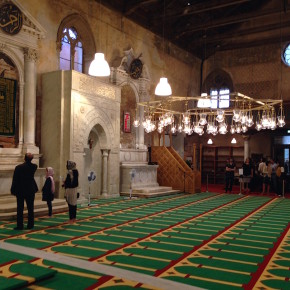
-
The now defunct Icelandic Mosque, as part of the 56th Biennale di Venezia, All The World’s Futures, Photograph by Katy Hamer, 2015
-
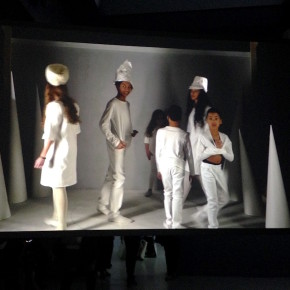
-
Joan Jonas, Installation/Video detail, as part of the 56th Biennale di Venezia, All The World’s Futures, Photograph by Katy Hamer, 2015
-
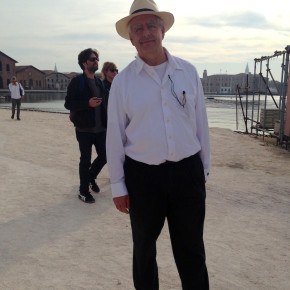
-
Artist William Kentridge outside the Arsenale, as part of the 56th Biennale di Venezia, All The World’s Future, Photograph by Katy Hamer, 2015
-

-
Sarah Lucas, Representing the British Pavilion, as part of the 56th Biennale di Venezia, All The World’s Futures, Photograph by Katy Hamer, 2015
-
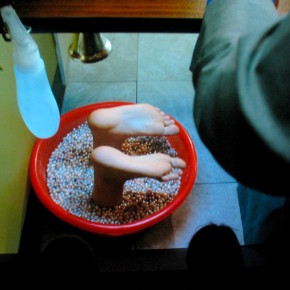
-
Mika Rottenberg, Video still, as part of the 56th Biennale di Venezia, All The World’s Future, Photograph by Katy Hamer, 2015
-
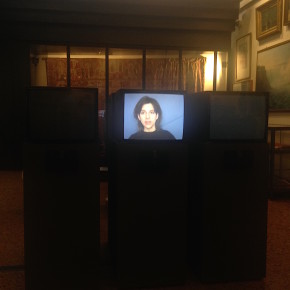
-
Nina Katchadourian, Installation view at the Armenian Pavilion on San Lazaro which won the Golden Lion, as part of the 56th Biennale di Venezia, All The World’s Futures, Photograph by Katy Hamer, 2015
-
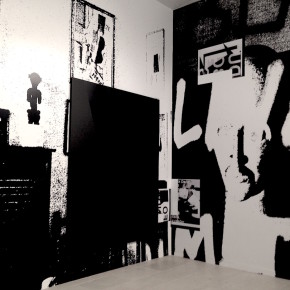
-
Adam Pendleton, Installation view at the Belgium Pavilion, as part of the 56th Biennale di Venezia, All The World’s Futures, Photograph by Katy Hamer, 2015
-
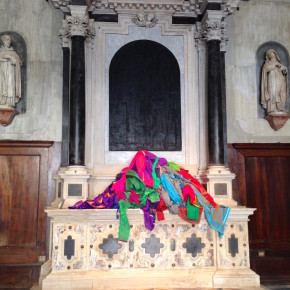
-
Patricia Cronin, Shrine For Girls, San Gallo, as part of the 56th Biennale di Venezia, All The World’s Futures, Photograph by Katy Hamer, 2015
-
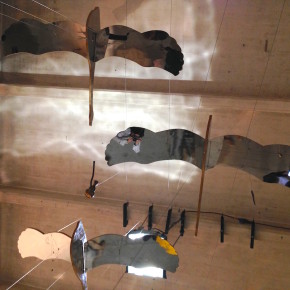
-
Qiu Zhijie, JingLing Chronical Theater Project, 2010-2015, as part of the 56th Biennale di Venezia, All The World’s Futures, Photograph by Katy Hamer, 2015
-

-
Pamela Rosenkranz at the Swiss Pavilion, Installation view, as part of the 56th Biennale di Venezia, All The World’s Futures, Photograph by Katy Hamer, 2015
-
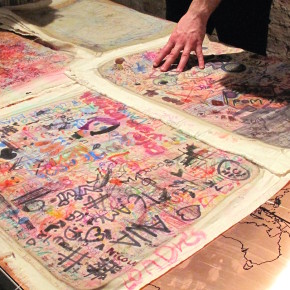
-
Oscar Murillo, Frequencies (an archive yet possibilities), 2013-ongoing, (canvas placed on the desks of children around the world), as part of the 56th Biennale di Venezia, All The World’s Futures, Photograph by Katy Hamer, 2015
-
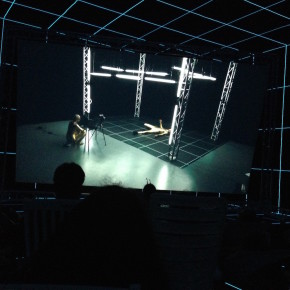
-
Hito Steyerl installation view at the German Pavilion, as part of the 56th Biennale di Venezia, All The World’s Futures, Photograph by Katy Hamer, 2015
-
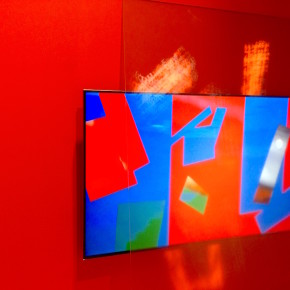
-
Monica Bravo, ARCHE-TYPES, The sound of the word is beyond sense, 2015, as part of the 56th Biennale di Venezia, All The World’s Futures, Photograph by Katy Hamer, 2015
-

-
Monica Bonvincini, Latent Combustion, installation detail, 2015 as part of the 56th Biennale di Venezia, All The World’s Futures, Photograph by Katy Hamer, 2015
-
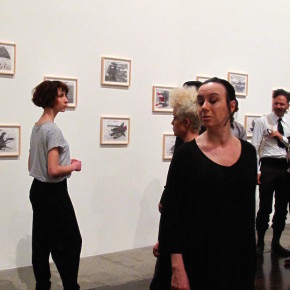
-
Performance view at the Arsenale by Allora & Calzadilla, as part of the 56th Biennale di Venezia, All The World’s Futures, Photograph by Katy Hamer, 2015
-
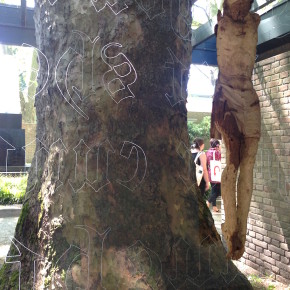
-
Danh Vo, mothertongue, curated the Danish Pavilion, detail, as part of the 56th Biennale di Venezia, All The World’s Futures, Photograph by Katy Hamer, 2015
-

-
Salvador Dali on the Merv Griffin Show, 1965, Installation view, as part of the 56th Biennale di Venezia, All The World’s Futures, Photograph by Katy Hamer, 2015
-
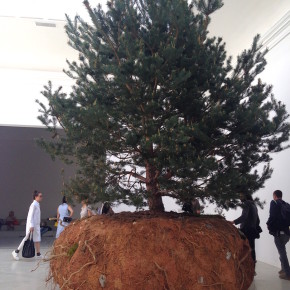
-
Pavilion of France, Giardini, as part of the 56th Biennale di Venezia, All The World’s Futures, Photograph by Katy Hamer, 2015
-
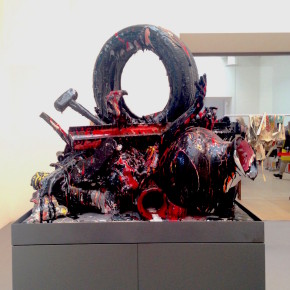
-
Walead Beshty, Installation view (La Voz de Jalisco El Periodico Que Dice Lo Que Otros Callan Mas Noticias Mas Deportes!-Domingo, 18 de Agosto 2013: Metro La Prensa Jalisco Express Guadalajara), 2013, as part of the 56th Biennale di Venezia, Photograph by Katy Hamer, 2015
-
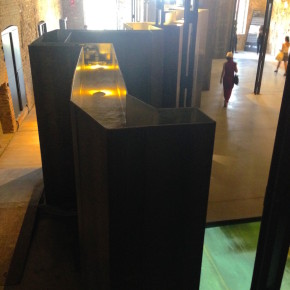
-
Mexican Pavilion, Installation view as part of the 56th Biennale di Venezia, All The World’s Futures, Photograph by Katy Hamer, 2015
-
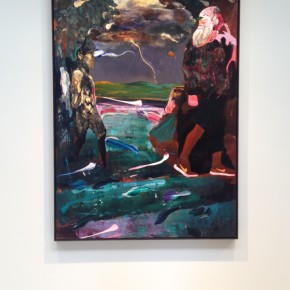
-
Adrian Ghenie at the Romanian Pavilion in the Giardini, part of the 56th Biennale di Venezia All The World’s Futures, Photograph by Katy Hamer, 2015
-

-
The Studio Museum, Harlem, Staff and Friends on tour during the Preview of the 56th Biennale di Venezia, Photograph by Katy Hamer, 2015
-

-
Charles Lim, Video installation view at the Singapore Pavilion, as part of the 56th Biennale di Venezia, All The World’s Future, Photograph by Katy Hamer, 2015
-
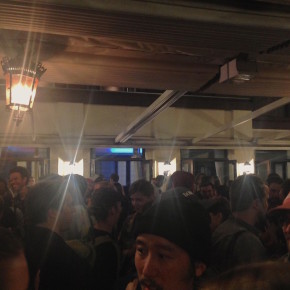
-
DIS Magazine Party, Photograph by Katy Hamer, 2015, Venice




